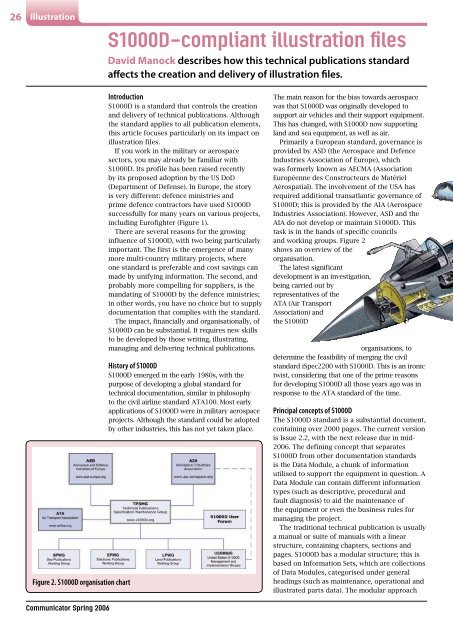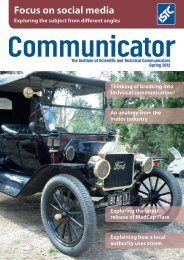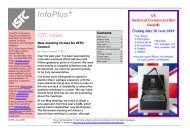S1000D-compliant illustrations - ISTC
S1000D-compliant illustrations - ISTC
S1000D-compliant illustrations - ISTC
Create successful ePaper yourself
Turn your PDF publications into a flip-book with our unique Google optimized e-Paper software.
26 Illustration<br />
<strong>S1000D</strong>-<strong>compliant</strong> illustration files<br />
David Manock describes how this technical publications standard<br />
affects the creation and delivery of illustration files.<br />
Figure 2. <strong>S1000D</strong> organisation chart<br />
Introduction<br />
<strong>S1000D</strong> is a standard that controls the creation<br />
and delivery of technical publications. Although<br />
the standard applies to all publication elements,<br />
this article focuses particularly on its impact on<br />
illustration files.<br />
If you work in the military or aerospace<br />
sectors, you may already be familiar with<br />
<strong>S1000D</strong>. Its profile has been raised recently<br />
by its proposed adoption by the US DoD<br />
(Department of Defense). In Europe, the story<br />
is very different: defence ministries and<br />
prime defence contractors have used <strong>S1000D</strong><br />
successfully for many years on various projects,<br />
including Eurofighter (Figure 1).<br />
There are several reasons for the growing<br />
influence of <strong>S1000D</strong>, with two being particularly<br />
important. The first is the emergence of many<br />
more multi-country military projects, where<br />
one standard is preferable and cost savings can<br />
made by unifying information. The second, and<br />
probably more compelling for suppliers, is the<br />
mandating of <strong>S1000D</strong> by the defence ministries;<br />
in other words, you have no choice but to supply<br />
documentation that complies with the standard.<br />
The impact, financially and organisationally, of<br />
<strong>S1000D</strong> can be substantial. It requires new skills<br />
to be developed by those writing, illustrating,<br />
managing and delivering technical publications.<br />
History of <strong>S1000D</strong><br />
<strong>S1000D</strong> emerged in the early 1980s, with the<br />
purpose of developing a global standard for<br />
technical documentation, similar in philosophy<br />
to the civil airline standard ATA100. Most early<br />
applications of <strong>S1000D</strong> were in military aerospace<br />
projects. Although the standard could be adopted<br />
by other industries, this has not yet taken place.<br />
The main reason for the bias towards aerospace<br />
was that <strong>S1000D</strong> was originally developed to<br />
support air vehicles and their support equipment.<br />
This has changed, with <strong>S1000D</strong> now supporting<br />
land and sea equipment, as well as air.<br />
Primarily a European standard, governance is<br />
provided by ASD (the Aerospace and Defence<br />
Industries Association of Europe), which<br />
was formerly known as AECMA (Association<br />
Européenne des Constructeurs de Matériel<br />
Aérospatial). The involvement of the USA has<br />
required additional transatlantic governance of<br />
<strong>S1000D</strong>; this is provided by the AIA (Aerospace<br />
Industries Association). However, ASD and the<br />
AIA do not develop or maintain <strong>S1000D</strong>. This<br />
task is in the hands of specific councils<br />
and working groups. Figure 2<br />
shows an overview of the<br />
organisation.<br />
The latest significant<br />
development is an investigation,<br />
being carried out by<br />
representatives of the<br />
ATA (Air Transport<br />
Association) and<br />
the <strong>S1000D</strong><br />
organisations, to<br />
determine the feasibility of merging the civil<br />
standard iSpec2200 with <strong>S1000D</strong>. This is an ironic<br />
twist, considering that one of the prime reasons<br />
for developing <strong>S1000D</strong> all those years ago was in<br />
response to the ATA standard of the time.<br />
Principal concepts of <strong>S1000D</strong><br />
The <strong>S1000D</strong> standard is a substantial document,<br />
containing over 2000 pages. The current version<br />
is Issue 2.2, with the next release due in mid-<br />
2006. The defining concept that separates<br />
<strong>S1000D</strong> from other documentation standards<br />
is the Data Module, a chunk of information<br />
utilised to support the equipment in question. A<br />
Data Module can contain different information<br />
types (such as descriptive, procedural and<br />
fault diagnosis) to aid the maintenance of<br />
the equipment or even the business rules for<br />
managing the project.<br />
The traditional technical publication is usually<br />
a manual or suite of manuals with a linear<br />
structure, containing chapters, sections and<br />
pages. <strong>S1000D</strong> has a modular structure; this is<br />
based on Information Sets, which are collections<br />
of Data Modules, categorised under general<br />
headings (such as maintenance, operational and<br />
illustrated parts data). The modular approach<br />
Communicator Spring 2006






